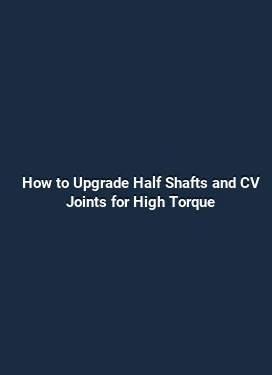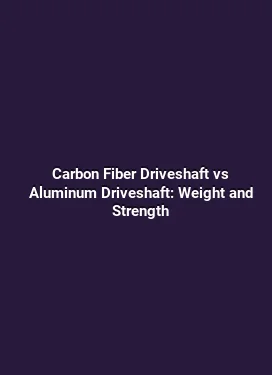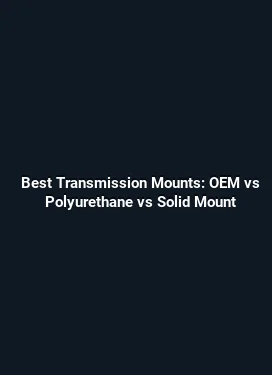Best Lightweight Flywheel Options: Aluminum vs Chromoly Steel Comparison
In modern performance and reliability-focused drivetrains, the flywheel plays a pivotal role in how the transmission responds to engine torque. The choice between aluminum and chromoly steel involves a balance of weight, inertia, heat management, and long-term durability. This article dives into the practical aspects of selecting a lightweight flywheel, explains how each material influences drivability, and provides concrete examples to help technicians, enthusiasts, and builders make informed decisions.
Overview of Flywheel Fundamentals and Material Implications

A flywheel serves multiple purposes: it stores rotational energy to smooth power delivery, reduces gear engagement shock, and influences engine-off deceleration behavior. The effective inertia of a flywheel is a product of its mass and how that mass is distributed relative to the axis of rotation. When engineers target a lighter component, they must weigh the benefits of reduced rotational inertia against potential drawbacks in smoothness and torque capacity. Aluminum and chromoly steel are the two most common materials used in performance-grade, aftermarket, and OEM flywheels, each offering distinct advantages and trade-offs.
The core performance signal for a lightweight option is inertia management. A flywheel with lower inertia responds faster to throttle input, improves rev matching during gear changes, and can help achieve crisper clutch engagement in manual transmissions. However, too little inertia can lead to abrupt engine deceleration when the clutch is disengaged or during aggressive downshifts, especially in high-triction clutches or in setups with torque converters in some transmissions. The engineering challenge is to shape the flywheel so that it provides adequate energy storage while limiting rotational mass enough to benefit throttle response and shift speed.
Material choice influences several practical aspects: heat dissipation under heavy use, resistance to thermal cycling, stiffness of the flywheel, fatigue life under repeated engagement, and the ability to machine precise balancing features. Aluminum alloys, often used in billet or forged forms, offer significant weight reductions but can be more sensitive to heat and wear under severe conditions. Chromoly steel, a chromium-molybdenum alloy, provides robustness, higher modulus, and excellent fatigue resistance at modest weight penalties. Understanding how these properties translate into real-world performance is essential for selecting the right part for a given drivetrain and driving style.
Aluminum Flywheels: Weight, Inertia, and Real-World Benefits
Aluminum flywheels are widely favored for their low mass and favorable stiffness-to-weight ratio. In performance-oriented builds, a lighter flywheel can reduce rotating inertia by a meaningful margin, enabling quicker engine response and faster engine RPM changes during upshifts and downshifts. The downsides typically manifest as changes in how the drivetrain handles torque fluctuations and heat during repeated hard use.
In terms of weight, aluminum flywheels can achieve substantial reductions compared with steel. A typical performance aluminum flywheel may weigh 6 to 9 pounds (2.7 to 4.1 kg) for a small to mid-sized engine, though larger applications can differ. The reduced mass translates to faster acceleration of the crankshaft and quicker engine speed transitions. For street-driven cars, the benefit is often immediately noticeable in daily drivability and lighter clutch pedal effort during engagement, especially with a hydraulically assisted clutch system.
Heat management is a critical consideration. Aluminum conducts heat well, but aluminum flywheels used in high-load scenarios rely on careful design to avoid hot spots and deformation. Many aluminum options incorporate high-thermal-conductivity features, dissipative frictions, or segmented heat-dissipation channels within the flywheel body. Additionally, the mating friction surface (the surface that engages the clutch) is often treated or coated to withstand heat and wear. For endurance events or frequent track use, aluminum can be pushed to its limits if the design does not address heat management and sustained torque loads.
Balancing accuracy is essential for any flywheel, but aluminum units may require more precise machining due to thermal sensitivity. A balanced flywheel reduces vibration transfer into the crank and drivetrain, contributing to smoother operation at high RPMs. In practice, buyers should seek components with certified dynamic balancing, traceable to a tested rpm range, and compatible with the engine’s exact bolt pattern and flywheel clamping method. When combined with a lighter flywheel, clutch interaction becomes more sensitive to alignment and torque strap or spline engagement, demanding meticulous installation and torque sequencing.
From a practical standpoint, aluminum flywheels are excellent choices when the application emphasizes immediate throttle response and reduced weight for daily driving or club-style track sessions. They pair well with lightweight flywheel bolts, high-performance clutch kits, and gearboxes tuned for rapid engagement. The cost is typically favorable relative to billet chromoly options, but variations in heat treatment and surface finishing can influence durability over the long term.
The Practical Trade-Offs with Aluminum

For enthusiasts, the most valuable aspects are how the car feels behind the wheel and how the transmission responds to shifts. Aluminum flywheels often deliver crisper throttle response, quicker rev hang reduction, and a lighter pedal effort profile. However, as heat accumulates in aggressive driving scenarios, there is potential for accelerated wear of the friction surface if the clutch system is not properly matched and cooled. For vehicles with heavy start-stop traffic or limited heat management capacity in the engine bay, aluminum may require additional attention to clutch technology and cooling strategies to sustain reliability.
Installation considerations include ensuring compatible bore, bolt pattern, and ring gear dimensions. Some aluminum flywheels are designed for specific hub lengths or require a particular starter ring gear mounting method. In high-performance builds, the user should verify that the selected aluminum component does not compromise the engine’s ability to sustain high RPMs during spirited driving. As with any lightweight option, the goal is balance: maximizing response without sacrificing reliability over the life of the transmission and engine bearings.
Chromoly Steel Flywheels: Strength, Durability, and Long-Term Performance
Chromoly steel flywheels strike a different balance by combining robust strength with a relatively modest weight penalty compared to pure steel. The presence of chromium and molybdenum in the alloy improves hardenability, reduces the risk of cracking, and enhances resistance to fatigue under repeated load cycles. In many performance and racing applications, chromoly steel flywheels occupy a middle ground between all-steel units and aluminum solutions, offering a compelling compromise for drivers who demand durability and consistent performance across a wide temperature envelope.
Mass and inertia economics are important when selecting chromoly steel. While heavier than aluminum, chromoly options can still be lighter than traditional cast iron or basic steel flywheels, depending on the design and the number of cutouts or lightening features. This balance helps maintain reasonable rotational inertia while delivering improved heat tolerance and long-term reliability. The practical effect is a more predictable engagement behavior under repeated launches and consecutive hard shifts, especially in manual transmissions and performance clutches designed for endurance use.
Durability under heat and stress is one of chromoly steel’s strongest selling points. The alloy’s higher fatigue limit means it can tolerate more cycles of engaging and disengaging under demanding driving. In track or rally scenarios, chromoly flywheels tend to maintain balance more consistently across sessions and over time, reducing the risk of warping or ring gear contact issues that can complicate maintenance. This reliability translates to less downtime and more confidence during long drives, events, or competitive sessions.
Manufacturing precision also matters for chromoly options. Machining tolerances, surface finishing, and balance quality are crucial, since the heavier material amplifies the effect of small deviations. A well-balanced chromoly flywheel with an optimized heat-treated friction surface will work in harmony with high-performance clutches and lightweight pressure plates. In daily driving, the slightly higher inertia may be imperceptible, but in aggressive driving, the benefit is a smoother, more controlled power transfer and reduced torque irregularities through the drivetrain.
Where Chromoly Shines in Real-World Scenarios
For vehicles subject to sustained power output, turbocharged or supercharged builds, and racing environments, chromoly flywheels provide a stable platform for repeated high-load engagements. The improved fatigue resistance means longer intervals between maintenance, reduced risk of micro-cracks forming due to heat cycling, and more consistent transmission feel as the engine heats and cools during events. In addition, the compatibility with a broad range of clutch setups makes chromoly a versatile choice for builders who plan to modify cam profiles, boosting levels, or traction control strategies over time.
Also, chromoly designs often emphasize balanced lightening patterns that preserve essential inertia where it matters while removing excess mass in non-critical areas. This design philosophy helps maintain adequate energy storage for smooth running while shaving weight where it benefits throttle response. When paired with properly matched clutches and flywheel bolts, chromoly wheels can deliver a long service life with repeatable engagement characteristics across a wide velocity range.
Choosing the Right Flywheel: A Practical Guide for Transmission Upgrades
When selecting between aluminum and chromoly steel, consider several practical criteria beyond raw weight. First, evaluate the intended application: street-only, daily driving with occasional spirited sessions, or professional-track use. Second, examine heat management capabilities of the cooling system, engine bay airflow, and whether the vehicle experiences high-load operation for extended periods. Third, assess clutch compatibility, including friction materials, pressure plate stiffness, and engagement behavior that aligns with the flywheel’s inertia profile. Finally, confirm the availability of support components such as the starter ring gear, pilot bearing surfaces, and proper bolt patterns to ensure reliable installation.
A structured decision framework helps. If the goal is immediate throttle response with a balance of daily drivability, an optimized aluminum flywheel designed for heat resistance and precise balancing can be ideal. If durability under repeated high-load conditions, reliability across many sessions, and predictable behavior under varied temperatures are priorities, chromoly steel provides a compelling, robust option. In both cases, an emphasis on precision manufacturing, dynamic balancing, and high-quality friction surfaces yields the most consistent results over time.
Real-World Scenarios and Example Setups
Consider a lightweight RWD or mid-engine sports car used for weekend track days. An aluminum flywheel paired with a performance organic or ceramic clutch may deliver noticeable gains in shift speed and throttle response, while keeping pedal effort reasonable. For a tourer with high-mileage track sessions and frequent heat exposure, a chromoly flywheel with a well-engineered friction surface improves longevity and maintains consistent engagement across sessions. In some cases, builders opt for a staggered approach: using a lighter flywheel during track days and switching to a more robust version for long-distance events that demand steady reliability.
Additionally, the installation environment matters. A well-ventilated engine bay, adequate cooling channels around the exhaust, and a clean, well-lubricated starter ring gear area contribute to successful operation. Regular inspection of the flywheel, ring gear, and bolts for any signs of wear or misalignment helps prevent unexpected downtime. The goal is to harmonize the flywheel choice with the rest of the drivetrain to deliver predictable engagement, consistent acceleration, and durable performance for the intended use case.
Summary of Key Considerations for Lightweight Flywheels
To distill the practical guidance: choose aluminum for maximum responsiveness and lighter overall mass when the drivetrain and clutch system are well-matched to handle heat and wear. Opt for chromoly steel when endurance, durability, and consistent behavior under diverse conditions take priority, especially in high-load or race-oriented scenarios. Regardless of material, prioritize precise balancing, high-quality surface finishing for the friction interface, and compatibility with the engine, clutch, and ring gear geometry.
In performance and transmission design, the right flywheel is not simply about shedding weight; it’s about shaping how energy is stored, released, and managed through the clutch and gears. The result is a drivetrain that feels responsive, shifts cleanly, and remains reliable across a broad spectrum of driving conditions. By understanding the material properties, heat handling characteristics, and real-world wear patterns, builders can select a lightweight flywheel that aligns with their performance goals and maintenance expectations.






